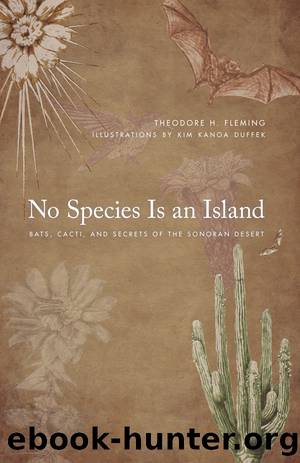No Species Is an Island by Unknown

Author:Unknown
Language: eng
Format: epub
ISBN: 9780816537556
Publisher: University of Arizona Press
In many hours of watching cactus flowers through a night vision scope, we never saw pallid bats visit cardon flowers at Tortilla Flats. They would have been easy to spot because they always land on flowers, in contrast to Leptos, which usually hover briefly at flowers. Based on indirect evidence (in addition to seeing pollen on their fur), however, we know that they must be avid cactus flower visitors in some parts of their geographic range. Our indirect evidence comes from the carbon composition of pallid bat muscle tissue. We studied this tissue, which we obtained mostly from dried museum specimens, because its carbon composition tells us the relative importance of two different kinds of plants in an animalâs diet. Or if the animal is a predator or carnivore rather than an herbivore, then the carbon composition tells us what kinds of plants its prey species are eating.
This method of ecological sleuthing is called stable (i.e., nonradioactive) isotope analysis, and it is pretty high tech because it uses a mass spectrometer to count the carbon atoms in a sample. For example, in a piece of muscle tissue. In the case of carbon, this technique counts its two stable isotopesâ12C and 13C. These two isotopes differ in the number of neutrons in each carbon atom. 13C, the less common isotope, has an extra neutron and hence is slightly heavier than the much more common 12C. Back in Miami, we used a mass spectrometer to determine the ratio of 13C : 12C in our tissue samples.
Now back to those two groups of plants. One group, technically known as C3 plants, has a relatively low ratio of 13C : 12C in its tissues, which are enriched in 12C relative to 13C. C3 refers to the photosynthetic pathway these plants use to remove carbon (in the form of CO2) from the air and convert it into new plant material. Most plants in the world are C3 plants. The other group, which actually contains two groups, uses a different photosynthetic pathway to capture carbon. These plants are called C4 or crassulacean acid metabolism (CAM) plants, and their tissues are enriched in 13C relative to 12C. It turns out that cacti, agaves, and tropical grasses such as corn have this higher stable isotope ratio, and their tissues can be readily distinguished from those of C3 plants based on this ratio. In the Sonoran Desert only cacti and agaves are CAM plants with a high carbon stable isotope ratio. All the other plantsâthe mesquites, paloverdes, ironwood, desert willows, and so onâare all C3. So any animal whose tissues are enriched in 13C must either be feeding on CAM plants or on animals that eat CAM plants.
We initially used stable carbon isotope analysis to determine the importance of CAM plants in the diet of the lesser long-nosed bat in different parts of its geographic range. We did this to address the question, how specialized is this bat on CAM plants (i.e., cacti and agaves)? Our analysis showed us
Download
This site does not store any files on its server. We only index and link to content provided by other sites. Please contact the content providers to delete copyright contents if any and email us, we'll remove relevant links or contents immediately.
The Lonely City by Olivia Laing(4768)
Animal Frequency by Melissa Alvarez(4427)
All Creatures Great and Small by James Herriot(4269)
Walking by Henry David Thoreau(3922)
Exit West by Mohsin Hamid(3795)
Origin Story: A Big History of Everything by David Christian(3666)
COSMOS by Carl Sagan(3588)
How to Read Water: Clues and Patterns from Puddles to the Sea (Natural Navigation) by Tristan Gooley(3432)
Hedgerow by John Wright(3316)
How to Read Nature by Tristan Gooley(3291)
The Inner Life of Animals by Peter Wohlleben(3285)
How to Do Nothing by Jenny Odell(3263)
Project Animal Farm: An Accidental Journey into the Secret World of Farming and the Truth About Our Food by Sonia Faruqi(3189)
Origin Story by David Christian(3170)
Water by Ian Miller(3155)
A Forest Journey by John Perlin(3042)
The Plant Messiah by Carlos Magdalena(2900)
A Wilder Time by William E. Glassley(2835)
Forests: A Very Short Introduction by Jaboury Ghazoul(2815)
